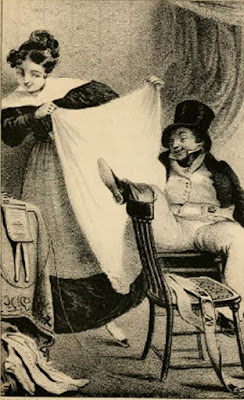Frances Milton Trollope (1780-1863)
by friend August Hervieau
A quilting. The signature might be P. Kelly Richardson
Most of the illustrations are nostalgic. Fanny's accounts lean the other way.
A summary of Mrs. Rapp's quilting from my book Civil War Women.
"The ladies of the Union are great workers, and, among other enterprises of ingenious industry, they frequently fabricate patchwork quilts. When the external composition of one of these is completed, it is usual to call together their neighbours and friends to witness, and assist at the quilting, which is the completion of this elaborate work. These assemblings are called 'quilting frolics' and they are always solemnized with much good cheer and festivity."
You can read the whole narrative fragment in her book published in 1832, although it's terribly mean, as is much of the book, particularly the views of the rural people she encountered in Tennessee and Kentucky.
She recorded an argument with a woman over the value of chintzes. The American was talking about chinch bugs (bedbugs) that she'd encountered in England and Fanny thought she meant chintz, "the material of a curtain," which she thought very pretty.
It is a pretty entertaining book and she does give us some insight into American behavior about 1830.
She recorded an argument with a woman over the value of chintzes. The American was talking about chinch bugs (bedbugs) that she'd encountered in England and Fanny thought she meant chintz, "the material of a curtain," which she thought very pretty.
It is a pretty entertaining book and she does give us some insight into American behavior about 1830.
"The fine ladies of Baltimore and Washington....I did not find that the leisure obtained by the possession of slaves was in many cases employed in the improvement of the mind. The finest ladies I saw either worked muslin or did nothing."
(Working muslin meant embroidering.) From Fanny's notebooks.She brought a few of her children and artist Auguste Hervieu with her for her tour (they hoped to repair her family's tenuous finances in America) and he illustrated her book with some drawings that are probably more observant than her paragraphs.
Theater-goers
Evening at a boarding house
Woman sewing a large bag
Live Stock, Virginia, 1830
Americans were incensed by the book, which became a best seller.
Cartoon capturing the American view of the critical Mrs. Trollope
Read her book here:
Volume 1
https://books.google.com/books?id=mo4IAAAAQAAJ&printsec=frontcover&source=gbs_ge_summary_r&cad=0#v=onepage&q&f=false
Volume 2
https://books.google.com/books?id=w35CAAAAcAAJ&source=gbs_navlinks_s
And see a biography:
Fanny Trollope: The Life and Adventures of a Clever Woman. Pamela Neville-Sington.












Must not have been much of a "frolic" judging by the looks of those ladies around the quilting frame. Perhaps they needed more of that sugared whiskey.
ReplyDeleteTact possibly not her best quality! But have to agree with her opinion of slaves! That undoubtedly didn't go down well with the upper crust folk! On the other hand, Charles Dickens was brilliant with his criticisms of the wealthy English - they thought his stories were great without realising he was making scathing observations of them and their appalling behaviour.
ReplyDeleteI'm quite sure many of us if not all of us would react negatively to any who would look on us from another culture, even a different part of the USA, without understanding the others point of view on our interesting differences in social, verbal, etc. customs.
ReplyDelete